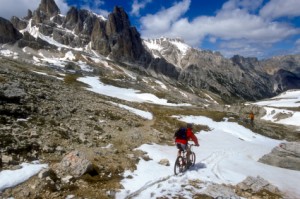Winter Biking
Unlike with some sports, biking can be enjoyed in all seasons, even a cold, wet winter.  There’s little difference in how you’ll care for your bike in the winter as opposed to other seasons. But you will have to perform maintenance more often to keep your equipment working smoothly. Every time your bike gets wet and there’s the possible that water has gotten anywhere that could freeze, you’ll need to practice some bike care.
There’s little difference in how you’ll care for your bike in the winter as opposed to other seasons. But you will have to perform maintenance more often to keep your equipment working smoothly. Every time your bike gets wet and there’s the possible that water has gotten anywhere that could freeze, you’ll need to practice some bike care.
No one wants to spend a chunk of time after each biking trip in the winter doing maintenance, though. So to help yourself speed through the necessary motions to keep winter damage from affecting your ride is to start the season with your bike in top condition, and make sure it’s clean and well-lubed.
Clean the bike thoroughly of all dirt and grit, then and wax it. Make sure your chain is clean by taking it off and dipping it solvent, brushing it and letting it dry. Then put the chain back on, and lube it as well as other moving parts and cables.
Now the key is to do this each time you’ve been through snow, slush or any kind of winter wet while biking, and make sure everything is dry when you’re done. If you start out with a very clean and well-lubed bike, the entire maintenance process should only take about 10 minutes. You won’t need to remove the chain each time, for instance, just clean and dry it. Because of the wax, dirt and grime should come off easily. Lubing everything will get faster each time you do it.
You might be thinking that you’ve ridden in the rain many times and not bothered with drying the bike when you were finished, with no problems later. While it’s true that a little wet isn’t that damaging to a bike (though you should know that it can cause rust and other problems), wet in the wintertime can cause a whole host of biking problems.
If you ride daily or very frequently in winter weather, then your bike is going to be exposed to water and ice, as well as salt and other elements much more than it would be in the summer, spring or fall. And that will take a toll, especially on the moving parts, and especially if you don’t keep them lubed and protected.
But any water that gets trapped in tiny parts of your bike now can basically end your biking for the season if it’s allowed to remain. Unless your bike is somewhere heated, the water remaining in the chassis or other small areas can and will freeze overnight. This can cause cracks and other damage.
Even if you only take your bike out once in the slush and store it until spring without cleaning and drying it out, any water in the bike can freeze and cause serious damage to things like the chassis, the brakes, and other important parts. Ten minutes after each winter biking trip can prevent these problems.
